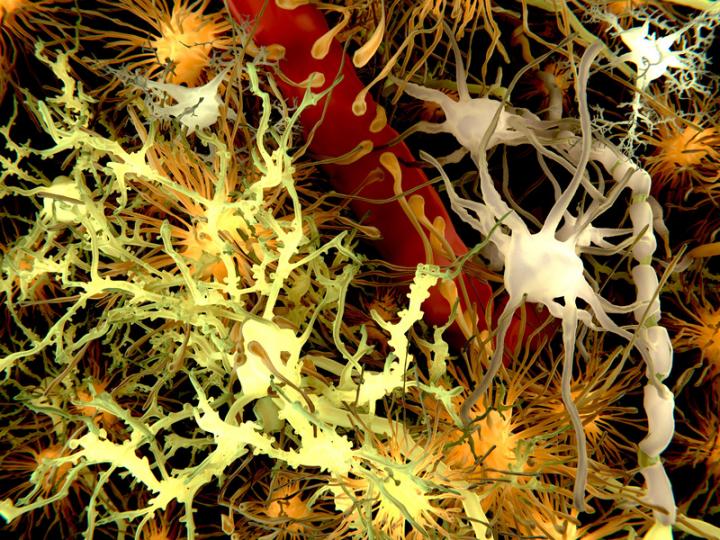Close Link Between Down Syndrome, Alzheimer’s Disease Unlocked By Researchers

Caption: Amyloid plaques are found in the brains of people with Down syndrome and Alzheimer's disease. Credit: Juan Gartner
A study entitled “SortingNexin 27 Regulates Aβ Production through Modulatingγ-Secretase Activity” published in the online issue of Cell Reports reveals common molecular mechanisms between Down syndrome and Alzheimer’s disease, with clear implications for the development of therapeutics against neuro-disorder diseases.
Down syndrome (DS), or trisomy 21 patients — who carry an extra copy of the 21 chromosome — have an increased risk of developing Alzheimer’s disease (AD). In fact, nearly 100 percent of DS patients by the age of 40 develop AD-like neuropathology. One of the characteristic AD phenotypes that is also observed in DS patients is the accumulation of neurotoxic beta-amyloid peptides. While the extra chromosome 21 in DS patients may lead to the overproduction of beta-amyloid precursor protein, the molecular mechanism of AD-like neurodegeneration in DS patients is still largely unclear.
Huaxi Xu, Ph.D., professor in the Degenerative Diseases Program at Sanford-Burnham and study lead author noted, “Our goal is to understand how the extra copy of chromosome 21 and its genes cause individuals with Down syndrome to have a greatly increased risk of developing dementia. Our new study reveals how a protein called sorting nexin 27 (SNX27) regulates the generation of beta-amyloid — the main component of the detrimental amyloid plaques found in the brains of people with Down syndrome and Alzheimer’s. The findings are important because they explain how beta-amyloid levels are managed in these individuals.”
In the study, the team of researchers using both in vitro and in vivo studies found that SNX27 regulates beta-amyloid production — down regulating SNX27 expression using RNAi technology increased beta-amyloid production, with over expression of SNX27 rescuing beta-amyloid levels. Additionally, the authors found that SNX27’s regulatory role of Aβ production occurs via modulating gamma-secretase activity, a key enzyme to Aβ generation.
SNX27 is important to maintain certain receptors at the surface of neurons that are required for proper synaptic function. Loss of SNX27 was shown to decrease synaptic function, leading to impaired learning and memory.
Xin Wang, Ph.D., first author of the publication, commented, “We found that SNX27 reduces beta-amyloid generation through interactions with gamma-secretase — an enzyme that cleaves the beta-amyloid precursor protein to produce beta-amyloid. When SNX27 interacts with gamma-secretase, the enzyme becomes disabled and cannot produce beta-amyloid. Lower levels of SNX27 lead to increased levels of functional gamma-secretase that in turn lead to increased levels of beta-amyloid.”
Thus, Xu concluded, “We have defined a rather complex mechanism that explains how SNX27 levels indirectly lead to beta-amyloid. While there may be many factors that contribute to Alzheimer’s characteristics in Down syndrome, our study supports an approach of inhibiting gamma-secretase as a means to prevent the amyloid plaques in the brain found in Down syndrome and Alzheimer’s.”
Previously, the authors demonstrated in DS that an extra copy of a microRNA encoded in chromosome 21 — miRNA-155 — reduced levels of SNX27. Thus, the new findings added an element to the pathway with reduced SNX27 levels, causing increased activity of gamma-secretase and leading to higher levels of beta-amyloid plaques in DS patients.
The authors suggest further studies are needed to advance knowledge of the correlation between both diseases: “Our next step is to develop and implement a screening test to identify molecules that can reduce the levels of miRNA-155 and hence restore the level of SNX27, and find molecules that can enhance the interaction between SNX27 and gamma-secretase. We are working with the Conrad Prebys Center for Chemical Genomics at Sanford-Burnham to achieve this,” added Xu.







